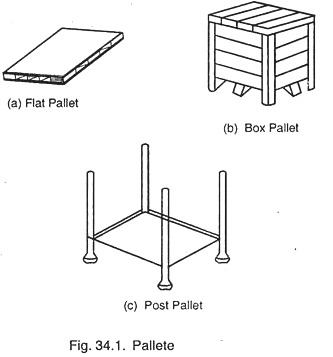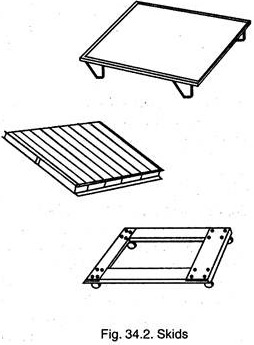After reading this article you will learn about:- 1. Concept of Unit Load 2. Characteristics of a Unit Load 3. Types 4. Securing the Unit Load 5. Designing the Unit Load System 6. Advantages.
Concept of Unit Load:
Principle of Unit Load states that, “it is quicker and economical to move a lot of items at a time rather to move each one of them individually”. In other words this principle suggested that, the larger the load handled, the lower the cost per unit handled.
For small parts, or parts where machines are engaged for handling, movements are made in containers. When machines are used for materials handling, units can be made machine size rather man size. Unit load principle implies that materials should be handled in most efficient, maximum size unit, mechanical means to reduce the number of moves needed for a given amount of material.
A number of items, or bulk material, so arranged or restrained that the mass can be picked up and moved as a single object too large for manual handing, and which upon being released will retain its initial arrangement for subsequent movement.
Characteristics of a Unit Load:
1. There should be minimum number of handlings.
2. Manual handling should be eliminated.
3. Materials are assembled into a unit load for economy of handling and storage.
4. Redesign packages, containers etc. for better assembly into unit loads and retain them to prevent product damage.
5. Unit load should be as large as possible within the constraints of building, equipment etc.
Types of Unit Loads:
These are the key to most unit load applications, and are made of wood, plywood, steel, light weight metals, plastic etc. These are constructed either a rigid one or collapsible to permit their return by common carrier in a minimum space.
1. Unit Load on a Platform:
(i) Pallet:
Pallet is a horizontal portable platform device used as a base for handling materials in a unit load. Pallet is basically a portable platform, with or without superstructure, and consists of two decks separated by bearers or a single deck supported by small feet and handled by means of fork lift trucks and pallet trucks. The pallets may be flat pallets, box pallets and post pallets, as shown in Fig. 34.1.
(ii) Skid:
These are non-stackable, single-faced device elevated above the floor to allow lifting by lift trucks. Goods may be loaded on the skids and then picked up with lift trucks. The skid can be loaded as a unit and transferred from position to position without subsequent loading and unloading like pallets as shown in Fig. 34.2.
2. Unit Load on a Sheet:
(i) Flat Sheets:
The sheet may be plain or corrugated, and made of cardboard, chip board or plywood.
(ii) Molded Sheets:
These are especially formed to facilitate building the load. These sheets are made in such way that they have hollow spaces for fork entry.
3. Unit Load on a Rack or Trays:
These racks or trays are designed to hold parts in a desired position and may have wheels. These are provided with inserts, holes or pegs or dividers for ease of handling and inspection etc.
4. Unit Load in a Container:
Containers are made in the form of full or partial enclosures to suit requirements. Containers include boxes, bins, crates etc.
5. Self-contained Unit Load:
These do not require auxiliary aids. Examples of such unit loads are bundles, bales, interlocked unit loads and fastened unit loads.
Securing the Unit Load:
Commonly used methods of securing the unit loads (unitizing) are:
1. Wire.
2. Steel trap.
3. Cloth or paper tape.
4. Adhesive.
5. Chip board or paper sheet.
6. Containers.
7. Clamps.
8. Interlocking.
Designing the Unit Load System:
(A) Factors considered for designing:
For designing (planning) the unit load system following factors should be considered:
1. Material and its characteristics.
2. Quantity to be handled and duration.
3. Starting point and destination.
4. Loading and unloading techniques.
5. Objective of space utilisation.
6. Environment, storage requirements in route.
7. Limitations of aisles, doors, height, column, machine arrangement, and storage space dimensions, etc.
8. Weight limitations.
9. Volume limitations.
10. Cost of handling equipment and other handling aids.
11. Cost of consumable (expendable) unitizing materials.
12. Labour cost.
13. Time consumed in preparing the unit load.
14. Cost of entire handling system.
(B) Criteria for unit load design:
1. Mechanical strength.
2. Low cost.
3. Disposable.
4. Optimum size.
5. Universal in application.
6. Stackable.
7. Easy to store.
8. Versatility.
9. Ease of unitising or de-unitising.
10. Low maintenance
(C) Unit Load Design:
After having understood the factors and criteria for unit load design, next step is to design (or plan) the unit loads. A logical approach must be followed to solve the unit load problem.
For this purpose following guidelines must be followed:
1. Whether unit load concept is necessary:
First of all it is necessary to determine whether there is need for unitizing at all? For this purpose size, volume, frequency of movement, distance, equipment used, cost justification, and customers’ acceptance are the main considerations. If it is found necessary to have unit load design, we should move to next step.
2. Selection of type of unit load:
Type of unit load is selected by considering the materials whether it can withstand load, and whether its irregular shape is strong enough to support the load.
3. Establish distribution requirement:
Objective of designing a unit load is more efficient shipping and subsequent handling, storage and disbursement.
4. Determining the size of unit load:
Size and shape of the unit load is decided considering the size and shape of the product, size of the shipping container.
5. Configuration of the unit load:
This includes the shape and pattern of the loading, shape and dimensions of the items to be unitised and whether the items are unstackable, whether auxiliary attachments like sides, ends or corners, or some kinds of container can be provided to unitize the load.
6. Method of building the unit load:
Method of building the load is decided considering different factors along with some additional factors, like, unitising aids, methods of building unit load i.e. manual, semi-mechanised or palletizers, and method of securing the unit load e.g. steel strap, wire, rope, tape of cloth or paper, adhesives, chip board or paper sheets, rubber bands, filament tapes, storage aids, interlocking etc.
Advantages of Unit Load Concept:
1. Possible to handle large loads.
2. Reduce handling cost of one unit.
3. Reduce packaging costs.
4. Maximise space utilisation.
5. Faster movement of materials.
6. Reduces loading and unloading time.
7. Reduces pilferage/damage during transit or storage.
8. Safer handling.
9. Reduces cost of transportation.

